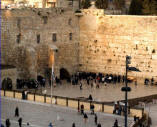|
|||||||||||||||||||||
|
Jerusalem, the Eternal Capital of Israel
-- King David designated Jerusalem as the
capital of Israel and the Jewish people 3,000 years ago and his son,
King Solomon built the first temple there. The temple was the center of
Jewish religious and national life. King Solomon and his descendents
ruled for over 400 years until the Babylonians conquered the city and
exiled its Jewish inhabitants.
-- The Jews were allowed access to the city
when the Arabs took control in the 5th century and resumed their worship
at the Kotel -- the Wailing Wal -- the last remnant of the Holy Second
Temple destroyed by the Romans. In the late 7th century the Dome of the
Rock – the conspicuous Arab mosque these days recognized by its golden
dome - was constructed on the temple mount. -- By 1187 Jerusalem was taken away from the Crusaders by Saladin, who allowed Jews and Arabs to return and inhabit the city. Though the period that Saladin ruled was a time of building and growth, with construction of many houses, markets and public bathes, the city did not gain in stature and was considered no more than a village, due to in fighting. -- From 1250 – 1517 Jerusalem changed hands a number of times and was besieged by many earthquakes and the black plague. -- From 1517 – 1917 Jerusalem and its surrounding area was controlled by the Ottoman Turks. Under Suleiman the Magnificent rule, Jerusalem enjoyed prosperity, peace and a rebuilding of the walls around the old city and their impressive Gates. It was also during that time that modernization entered the city, with the Turks’ introduction of the wheel as a mode of transportation, as well the oil lantern. The first paved road was constructed from Jaffa to Jerusalem in the mid-19th century and the railroad reached Jerusalem towards the end of that century. -- Jerusalem was annexed in 1831 by Muhammad Ali of Egypt and foreign consulates began to be established in the city. Ibraim Pasha, Muhammad Ali’s son succeeded his father in 1836 and allowed the Jewish residents of Jerusalem to rebuild and restore four major synagogues including the famous Hurva synagogue. -- Though the Ottoman’s reestablished their rule in 1840, many Egyptian Muslims chose to remain in the city, while a growing number of Jewish immigrants from Algiers and North Africa settled in Jerusalem. -- In the 1860s poor conditions within the old city such as extreme overcrowding and appalling sanitary conditions, prompted establishment of new neighborhoods outside the old city walls. These included the Russian Compound and Mishkenot Shaananim. -- The British Army under the leadership of General Edmund Allenby conquered Jerusalem and in 1922 the League of Nations assigned the United Kingdom the Mandate over Palestine, Transjordan and Iraq. -- Between 1922- 1948 there were clashes between Arab and Jews in all of Palestine. However, the British during this time built new garden suburbs in the northern and western part of Jerusalem. It was also during this period that universities were founded including the famous Hebrew University. -- 1948 - End of the British Mandate, as voted upon in the U.N. on November 29th, 1947 -- 5th day of Iyar - 1948, Israel declares its independence.
-- 1948 Expulsion
of Jews from the Old City of Jerusalem:
-- Jerusalem, Divided:
-- June 1967 - Jerusalem United Once
again:
 Mazor Guide to Yom Yerushalayim brings you much more about the holiday, its meaning and its traditions... See the links below.
MazorGuide Recommended Reading
-
A House of Prayer for All Nations: The Holy Temple of Jerusalem ~ by Chaim
Richman
|
|
|||||||||||||||||||
|
Mazor Guides: Wealth of Information and Resources Copyright 1998-2024 MazorNet, Inc. | http://www.MazorGuide.com | http://www.MazorBooks.com | http://www.Kosher-Directory.com | http://www.JewishCelebrations.com |
|||||||||||||||||||||










